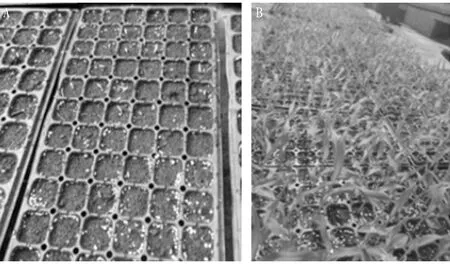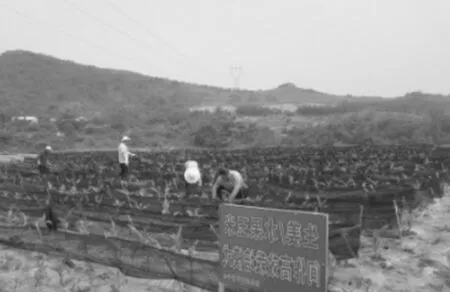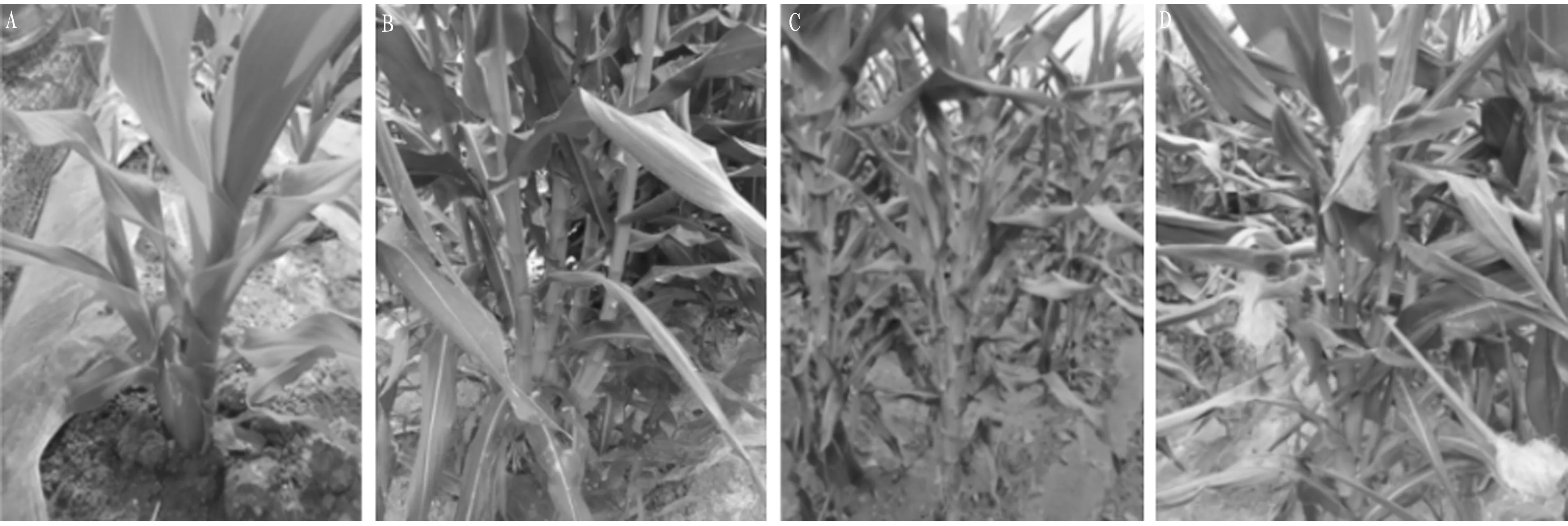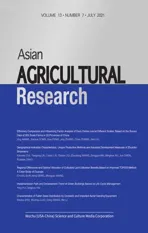Effect of Intercropping Ginger and Sweet Maize on Growth, Yield and Benefits
2021-09-24QingshengRENChengyongLI
Qingsheng REN, Chengyong LI
Jinan City Academy of Agricultural Sciences, Jinan 250316, China
Abstract Ginger is an important cash crop in Shandong Province and it usually takes the sole cropping in the production. In order to explore new ginger cultivation patterns and improve planting benefits, sweet maize (Jingengtian 1) was intercropped with ginger (Laiwu ginger). The plug seedling was performed for sweet maize on April 18. Ginger was planted with plastic film mulching on April 20, and double-row sweet maize seedlings were transplanted on the ridges of interlaced ginger fields on May 2. The sweet maize was harvested from July 18 to 25, and the tillering rate of sweet maize reached 100%. The number of tillers in intercropping was more than that of sole cropping, and the highest average tiller reached 5.32 per plant; when sweet maize was intercropped, the number of ears decreased by 17.35% and the ear weight decreased by 8.07%. Ginger was harvested on October 20, the number of branches of intercropping ginger decreased by 5.12% to 6.47%, and the rhizomes weight per plant decreased by 5.64% to 16.43%. The economic benefit of ginger intercropping sweet maize was higher than that of sole ginger cropping. The intercropping model increased the efficiency by 6.28% and 2.87% respectively in the two bases, and increased the net income by 12 000 and 5 000 yuan/ha, respectively.
Key words Ginger, Sweet maize, Intercropping, Growth, Yield
1 Introduction
Ginger is an important cash crop in Shandong Province and it usually takes the sole cropping in the production. At the early stage of ginger growth, it needs plastic mulch film for shading. Due to the influence of the market, diseases, and industrial structure, the ginger cultivation area and planting benefits have fluctuated greatly in recent years, which has affected agricultural efficiency and farmers’ income. Sweet maize is a new food that can be taken as both vegetable and fruit. It has the characteristics of being fresh, glutinous, tender and fragrant. In particular, sweet maize, also reputed as "fruit maize", is rich in nutrition and has high economic value. In recent years, the development of sweet maize in China is accelerating, and the planting area has gradually expanded from Guangdong, Guangxi, Shanghai and other places to the surrounding and northern regions. In Laiwu City of Shandong Province, ginger is usually cultivated in mid-to-late April. Laiwu also has spring maize planting. There is currently no report on the intercropping of ginger and sweet maize in Laiwu ginger production area. Laiwu is located in the middle of Shandong Province, we performed the experiment with the cultivation mode of ginger intercropped with sweet maize, studied the agronomic indicators, economic indicators, and planting benefits of ginger and sweet maize, and explored the feasibility of ginger intercropping sweet maize in Laiwu and surrounding areas to increase the planting benefits of ginger production areas in Laiwu and middle areas of Shandong Province.
2 Materials and methods
2.1 Experimental materials
The experiment was carried out in Gaozhuang Experimental Base and Xuexie Experimental Base of Jinan City No.2 Academy of Agricultural Sciences in 2018. The previous crops in the experimental field were all ginger, the soil fertility was medium, and there were no other maize varieties planted in the surrounding area.Experimental crop varieties included Laiwu ginger and Jingengtian 1 sweet maize.
2.2 Experiment design
2.2.1
Site preparation and fertilization. In the ginger planting field, combined with site preparation, the bio-organic fertilizer60 m/ha was applied as base fertilizer, and ditches were opened at 80 cm row spacing (row spacing is 10 cm wider than conventional sole ginger cropping) for intercropping ginger with sweet maize. At the same time, ditches were opened at 70 cm row spacing for sole ginger cropping. When sowing ginger, potassium sulfate compound fertilizer (N∶P∶K=15∶6∶21) 750 kg/ha was applied as the seed fertilizer.Sole cropping sweet maize field followed the conventional management measures, combined with the site preparation, 30 m/ha of decomposed chicken manure, 450 kg/ha of potassium sulfate compound fertilizer, and 50 kg/ha of superphosphate were applied.
2.2.2
Topdressing at suitable time. To prevent the sweet maize seedlings from excessive growth, the topdressing time of T1-1 and T1-2 ginger seedlings should be performed in late June, which is 10 days later than T3-1 and T3-2 (mid-June), and 750 kg/ha of bio-organic fertilizer should be applied. After the sweet maize was harvested in mid-August, the maize stalks were removed, the T1-1 and T1-2 ginger were topdressed for the second time, and the compound fertilizer was topdressed 450 kg/ha; in mid-September, when the ginger seedlings had 6-8 branches, 450 kg/ha of bio-organic fertilizer should be topdressed.For T2-1 and T2-2 sole cropping sweet maize field, the normal water and fertilizer management was adopted, 75 kg/ha of urea was applied when transplanting; at the small bell-mouth stage, combined with field tillage and weeding, 150 kg/ha of urea and 15 kg/ha of potassium sulfate should be topdressed; at the silking stage, 225 kg/ha of urea and 75 kg/ha of potassium sulfate should be topdressed.
2.2.3
Experimental design of ginger and sweet maize. After the ginger shoots have grown out, they would be sown on April 20 with plastic film mulching method. The intercropping field adopted 20 cm plant spacing and the sole cropping field adopted 25 cm plant spacing. The plug seedling of sweet maize was performed on April 18, as shown in Fig.1A. On May 2, the seedling breeding of sweet maize was completed, as shown in Fig.1B. At intervals of a ginger field ridge, double-row sweet maize seedlings were transplanted on the field ridges with a plant spacing of 30 cm. In addition, sweet maize was planted in two different experimental sites as the sole cropping, using big and small rows, the big row was 80 cm wide, and the small row was 60 cm wide, and the plant spacing was 30 cm. The specific experimental design was as follows: T1-1 was ginger intercropping sweet maize in Gaozhuang base; T1-2 was ginger intercropping sweet maize in Xueye base; T2-1 was sole sweet maize cropping in Gaozhuang base; T2-2 was sole sweet maize cropping in Xueye base; T3-1 was sole ginger cropping in Gaozhuang base; T3-2 was sole ginger cropping in Xueye base.
Note: A. plug seedling; B. seedlings.
2.3 Data processing
The data were sorted out and analyzed with the aid of Microsoft of Excel 2007.3 Results and analysis
3.1 Shading at the ginger seedling stage
Laiwu is situated in the middle of Shandong Province, and the ginger seedlings should be properly shaded at the seedling stage. Combining ginger planting time and cultivation methods, ginger was intercropped with sweet maize. The plant height of sweet maize in the early stage was relatively short and cannot provide sufficient shade for the ginger seedlings. Thus, at the seedling stage, ginger seedlings should be properly shaded, as shown in Fig.2. In early June, when the sweet maize plants grew to be as high as 80 cm, the shading net could be removed. For the sole ginger cropping, normal shading measures were taken.
Fig.2 Shading measure for early growth stage of ginger in the intercropping field
3.2 Effects of different cultivation modes on sweet maize tillering
Sweet maize started to tiller at the root base in late May, as shown in Fig.3A, and gradually increased. The intercropping mode reached up to 6 tillers in late July, as shown in Fig.3B. Some tillers at the root base had tassels at the top, but the tillers had not developed ears. With the growth of sweet maize, in late June, side branches started to appear continuously at the ear position, as shown in Fig.3C. Then, the tops of some side branches differentiated into ears, as shown in Fig.3D. In contrast, there were very few tillers at the root base of sweet maize in sole cropping fields, and no side branches developed at the ear position.According to some studies, the tillering of sweet maize does not affect the yield, and even has the effect of increasing yield. In the intercropping fields of this experiment, during the growth of sweet maize, in order to prevent the excessive shading of the tillers from affecting the growth of ginger, the tillers at the root base of sweet maize were continuously removed.
3.3 Effects of ginger and sweet maize yield and its components in different cultivation modes
From Table 1, it can be known that whether it is ginger and sweet maize intercropping or sole sweet maize cropping, there were fewer sweet maize tillers in the experimental field in Gaozhuang base, especially the T2-1 treatment sweet maize had very few tillers, with an average of only 0.01 per plant, the average number of ears in this treatment was the largest and the average ear weight was also higher. These indicate that the yield components of sweet maize in this treatment was more balanced and the yield was higher. The T1-2 treatment in the experimental field of Xueye base had more tillers, with an average of 5.32 per plant, which affected the yield components such as plant height, ear number, ear weight,etc.
This treatment had less ear number and ear weight.
Table 1 Growth conditions of sweet maize

Note: A. tillering at the root base of sweet maize, B. tiller increased at the root base of sweet maize, C. side branches appeared in sweet maize ear position, D. ears differentiated from the top of side branches of sweet maize in intercropping field.
In the same cultivation mode, the experimental field of Gaozhuang base had fewer tillers, higher plant height, fewer ears, less ear weight, and shorter growth period than the experimental field of Xueye base. This is possibly because of the regional microclimate difference. The Gaozhuang base experimental field is located in the Laiwu plain area, and the Xueye base experimental field is located in the northern mountainous area of Laiwu. The temperature difference between day and night is large, which is conducive to the accumulation of dry matter and the weight of the fruit is heavier. At the same time, the effective accumulated temperature in experimental field is less, leading to slow plant growth and prolonging of growth period. In the intercropping cultivation mode, the sweet maize had more tillers, and the average number of ears and average ear weight were lower, possibly because of the larger row spacing of sweet maize, better light conditions, and ventilation, which promotes the development and growth of sweet maize tillers, and the increase in tillers affects the growth and development of ears. Han Jinlinget
al.
studied the dry matter accumulation, distribution and transfer of spring maize under different planting densities and found that with the increase of density, the transfer rate and contribution rate of dry matter transfer from the stem sheath to the kernel have an increasing trend, which promotes ear development.The yield of sweet maize is divided into two methods: the number of ears of fresh fruit and the weight of ears of fresh fruit. Table 2 shows that whether it was intercropping or sole cropping, the sweet maize yield was higher in the Gaozhuang base.

Table 2 Yield of sweet maize in different cultivation modes
From Table 3, it can be seen that in the two experimental fields, ginger intercropping with sweet maize had a greater impact on the growth of ginger. The three-branch stage of ginger intercropping was delayed by 7-8 d compared with sole ginger cropping. The decrease of number of ginger branches, plant height and rhizome weight was obvious. Table 4 shows that the decline of some indicators of intercropping ginger in Xueye base was greater than that of Gaozhuang base.

Table 3 Indicators of ginger yield and its components
3.4 Economic benefits in different cultivation modes
At present, the sweet maize mainly sells fresh ears in the local market. The market price is 0.5 yuan/piece. The economic benefits of sweet maize: T1-1 was 26 041.88 yuan/ha, T1-2 was 20 416.83 yuan/ha, T2-1 was 32 142.83 yuan/ha, and T2-2 was 27 380.93 yuan/ha. Calculated at the current ginger market price of 5 yuan/kg, the economic benefits of ginger: T1-1 was 203 209.40 yuan/ha, T1-2 was 214 668.80 yuan/ha, T3-1 was 215 708.55 yuan/ha, and T3-2 was 228 520.00 yuan/ha. The comprehensive economic benefits of sweet maize and ginger are shown in Table 5, ginger intercropping sweet maize had higher comprehensive economic benefits than the sole ginger cropping. The income of Gaozhuang base and Xueye base increased to 13 542.75 and 6 565.60 yuan/ha, respectively, and the increase percentage reached 6.28% and 2.87%, deducting the cost of sweet maize seeds at 1 500 yuan/ha, the net income of intercropping ginger with sweet maize increased by 5 000-12 000 yuan/ha.
Table 4 Changes in the number of ginger branches, plant height and rhizome weight indicators in different treatments %

Table 5 Comprehensive economic benefits of different treatments
4 Conclusions and discussion
(i) Ginger intercropping sweet maize has higher comprehensive economic benefits than the sole ginger cropping. In this experiment, the increase percentage reaches 2.87% and 6.28%. Deducting the cost of sweet maize seeds at 1 500 yuan/ha, the income of intercropping ginger with sweet maize increases by 5 000-12 000 yuan/ha.
(ii) The growth and development of ginger and sweet maize are quite different in different cultivation modes and different regions. In terms of the overall rule of sweet maize tiller number, compared with the intercropping mode, the sole cropping mode is fewer in plain areas than in mountainous areas. T1-1 and T1-2 are 2.11 and 5.32 pcs/plant, respectively, and T2-1 and T2-2 are 0.01 and 0.22 pcs/plant, respectively. In the study of the rules of tillering occurrence of multi-tillering maize and the influence of density and sowing date, Wang Rufanget
al.
concluded that high light and heat and low density are conducive to tillering. In this experiment, Xueye base is located in the northern mountainous area of Laiwu, and the daytime light and heat conditions are better than the plains where the Gaozhuang base is located; in the intercropping mode, the overall density of sweet maize is reduced, and better light and heat conditions promote the occurrence of sweet maize tillers.(iii) In this study, the average number of branches, plant height, rhizome weight and other indicators of ginger are better in sole cropping mode than in intercropping mode. In the intercropping mode, ginger and sweet maize compete for water and fertilizer at the early stage of symbiosis, and sweet maize and ginger compete for water and fertilizer; in the later stage of symbiosis, when the plant height of sweet maize exceeds 1 m, as the plant height of sweet maize continues to increase, it will increasingly affect the photosynthesis of ginger. During the symbiosis time until the sweet maize is harvested, the net photosynthetic rate, stomatal conductance, intercellular COconcentration and transpiration rate of ginger are all lower than the sole cropping mode.
(iv) For the ginger intercropping sweet maize cultivation model, the use of nutrient-bowl seedling technology can ensure that the whole maize seedling is strongand improve the growth potential of maize. It is necessary to improve ginger planting methods by plastic film mulching and transplanting and other techniques before ginger planting, and transplant maize seedlings as early as possible, to reduce auxiliary shading measures for ginger and reduce input costs.
(v) For the ginger intercropping with sweet maize, it is necessary to improve the water and fertilizer management. Both ginger and sweet maize have higher requirements for fertilizer and water. Especially in order to adjust the growth potential of ginger in the symbiosis period with sweet maize and in the middle and late stages, it is necessary to take proper water and fertilizer management. Integrated management of water and fertilizer can significantly increase the pigment content and net photosynthetic rate of ginger leaves, reduce transpiration rate, and increase water use efficiency, thereby promoting the growth of ginger in the middle and late stages.
杂志排行
Asian Agricultural Research的其它文章
- Efficiency Comparison and Influencing Factor Analysis of Dairy Farms over/at Different Scales: Based on the Survey Data of 263 Scale Farms in 22 Provinces of China
- Regional Differences and Optimal Allocation of Cultivated Land Utilization Benefits Based on Improved TOPSIS Method: A Case Study of Guangxi
- Characteristics of Fallen Seed Distribution by Domestic and Imported Aerial Seeding Equipment
- Thoughts on Present Situation of Development of Rural Animal Husbandry and Its Relationship with Construction of Ecological Agriculture and Revitalization of Rural Industry
- Implementation Path and Development Trend of Green Buildings Based on Life Cycle Management
- Hot Spot Analysis and Development Trend of Intelligent Roof Parking Lot: Bibliometric Analysis Based on CiteSpace Visualization Software
